
Another month, another cooking challenge completed. This was the second round and we had some great dishes, but you, the voter has spoken and the hat’s go off to Casey’s Date and Ginger Couscous Pudding.
Last month we got to know a bit about what got her cooking, so this month I was curious about what’s in the future for her and her blog. Here’s what she’s cooking up:
“The next three months should be quite exciting as Spring is right around the corner. I hope to have some great posts coming up about getting my garden going, plus I am hoping to learn some traditional Bulgarian cheese-making techniques, which I hope to share with my readers.
In honor of St. Patrick’s day, I will be curing my own beef for corned beef and cabbage, plus Irish soda bread and maybe some Irish whiskey cupcakes. The international women’s club that I am a member of will be hosting some French cooking demo’s so I am excited to write about learning some new things.
In April, I will be in be back in the United States, so I hope to be able to sample some great food and find new and interesting stuff to smuggle back in my suitcases!”
That certainly sounds exciting. And to keep our little challenge interesting, I asked Casey to choose the next three ingredients:
Meat (beef, pork or lamb)
Edible Flowers (whatever is available locally)
Shallots
I’ve never eaten my flowers…, this should be interesting. Who’s ready for a new challenge? Here’s a little reminder of how things work:
All recipes must be submitted by the 20th of the month
One recipe will be randomly selected as the TCIY Recipe of the Month
Winning recipe will be announced on the 25th of the month on this blog
I’m sorry. I’ve neglected my responsibilities in the bartending department. I know. It’s a terrible, unforgivable offense. I will do better. How about I make it up to you with this little yummy gem?

Lemon Drop Martini
Makes 2 servings; trust me, you won’t be able to stop at 1
3 oz vodka
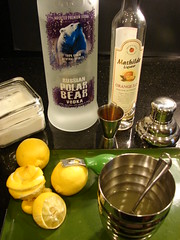 1 oz orange liqueur (like Triple Sec, Grand Marnier, etc.)
1 oz orange liqueur (like Triple Sec, Grand Marnier, etc.)
2-3 tsps sugar
1-1/2 oz fresh lemon juice (about 2-3 lemons)
Ice cubes
Martini glasses
Sugar for dipping
Lemon twist/peel
Yes, you want fresh lemon juice. Suck it up!
First, get your glasses ready. I like to fill my glass with ice and water, then I put them in the freezer while I mix the drink.
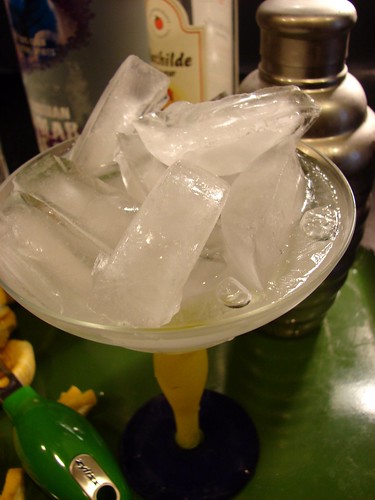
Second, dissolve the sugar: if you have a cocktail shaker, use that, otherwise a glass or measuring cup will do. Combine the sugar and vodka until completely dissolved. Then add the lemon juice and orange liqueur, and half-fill with ice; shake well.
Shake it until it feels like your hands will freeze… :-0 Set it aside, it’s time to rim the glasses.
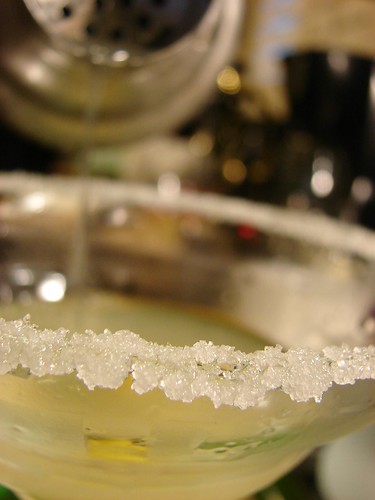
Empty the glasses and let the water drain a bit. Take a lemon wedge and rub it all around the edge of the glass so it is barely moist. Pour some sugar on a shallow plate, then dip the edge of the glass into the sugar.
Pour strained cocktail into the prettied-up martini glass and garnish with a lemon twist.

Leeks are new to me, at least I think they are. I was updating my mom with the menu for last weekend’s Foodbuzz event and she mentioned I did use leeks in Panama. She knows everything, but I’m not sure about this little fact.
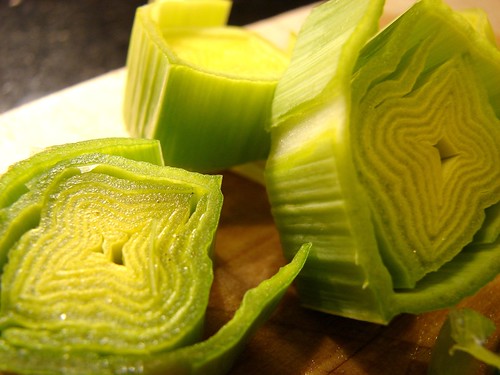
Nonetheless, I’ve quickly become a big fan of the elegant leafy… thing. I’ve used it as stuffing, in soups, but this is my first time making them an independent agent. I came across recipes for melted leeks as I conducted my research. Various methods and even more additions and omissions, in the end I settled on a recipe from the TomatoKnife. It was the simplest of them all, but the post sung its praises quite highly.
I hope you enjoy it as much as we did. This was the base for an awesome Seared Salmon with Beer Blanc.
Melted Leeks
4 cps leeks, chopped (about 3-4 bunches)
2 tbsp extra virgin olive oil
1 tsp sea salt
1/2 tsp black pepper, fresh
1 tbsp butter, optional
To prepare the leeks, first trim the bottom roots and remove the top leaves just where the stalk becomes green. You may need to peel off the first layer, as this one can be tough. Slit the stalk down the middle and wash each half under cool running water. Leeks grow close to the earth, so make sure you get in between those layers to get all the grit. Now you can chop them into half disks.
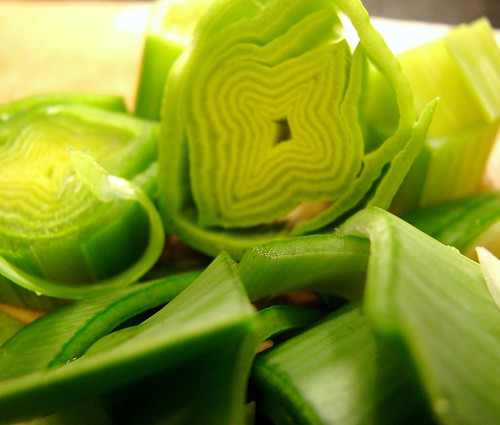
Slowly heat the olive oil in a saucepan over medium temperature, add the leeks, salt and pepper. Make sure to stir them well to coat them with the oil. Continue cooking and stirring occasionally to make sure they don’t stick to the bottom or begin to burn. You can cover them loosely in between stirs, but don’t go too far, it will take about 20 minutes for them to be.
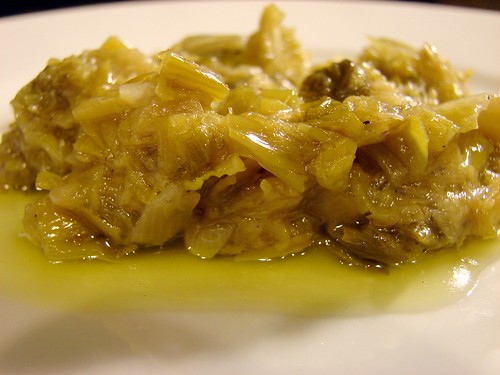
When ready, the leeks will be tender, almost pureed and beginning to brown. Add the butter just before serving, if you wish. Try these with this salmon recipe.
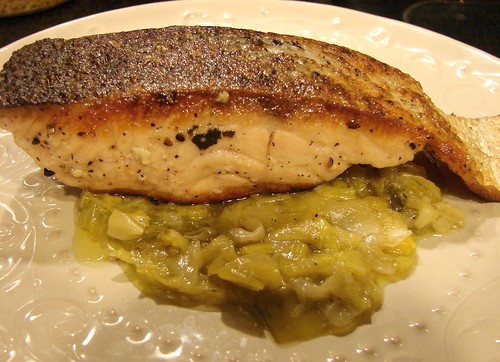

I’ve told you about my love affair with this little fishy, haven’t I? It sends me into a frenzy, the mere thought of it gives me goose bumps. I do a happy schammy dance. The dance looks suspiciously like the Bill Cosby’s no-movement dance. It makes me smile. It makes me feel clean. Salmon. Joy!
When I was putting together the menu for the Foodbuzz 24, 24,24 meal I, OF COURSE, found a way to add salmon to it. It represented the Pacific Northwest, and BOY, did it do that region proud!
I think salmon is perfect just the way it comes out of the water, so I don’t tend to dress it up too much. For this recipe, I allowed the fillets to marinate in some basic seasonings, then seared and served it with a beer sauce. While searching for ideas to prepare it, I found a clever little recipe for ‘Beer Blanc‘. I loved the play on words/concept (beurre blanc is a traditional French butter sauce). And since I often throw in beer into my sauces, it was off to the skillet. *I went with a Samuel Adams Irish Red.
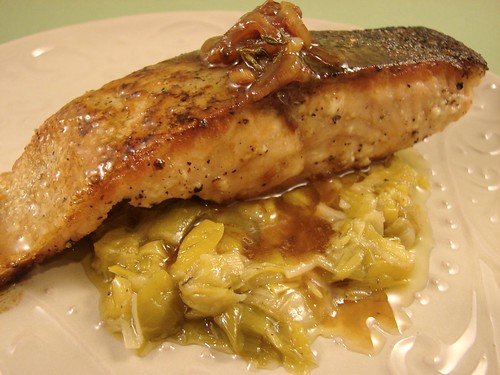
Pan Seared Salmon with Beer Blanc Sauce
4 salmon fillets (approx 4 ozs each)
2 tsps sea salt
1 tsp black pepper, ground
2 garlic cloves, crushed
2 tsps extra virgin olive oil
For the sauce (about 1 cp)
1/4 cp shallots, thinly sliced
8 oz red ale beer*
2 tbsp Malt vinegar
1 tbsp thyme leaves, fresh are best
2 tbsp butter, cut into pieces
Mix the salt, pepper, garlic and 1 tsp of olive oil in a shallow container, preferably glass. Work these ingredients into a paste and rub it on the salmon fillets. Set aside for 15-30 minutes.
Note about cooking the salmon: Do you like sushi? If you do, then allow me to suggest you cook salmon to medium. IMHO, the best way to enjoy this fish is just underdone. Salmon is naturally creamy, almost buttery, and this quality really comes through when you show some restraint when cooking it. I cannot tell you how often I’ve seen this cruelly overcooked to a dry, powdery, overly oily, and strong tasting mess. Please don’t do that salmon. It really deserves better.

See? Flaky but still creamy
Heat a nonstick skillet until it smokes, add the other teaspoon of oil and swirl it around to coat the bottom of the skillet. Carefully place the fillets on the skillet, skin-side down first. Sear the skin for 1-2 minutes depending on the thickness of the fillet. The ones I had were about 1-1/2 inches thick. You can look at the fillets from the side, the portion closest to the heat will begin to turn opaque. This is a good time to flip them onto the other side. Sear for another 1-2 minutes before removing from the skillet and allowing them hang out on a warm plate.

Once you’ve seared all the fillets, remove some of the oil rendered–you only need about 1 tbsp left in the skillet. Reduce the temperature to medium, add the shallots and cook until tender, about 4 minutes.

Deglaze the skillet with the beer, lower temperature to medium low and simmer until 3/4 of the liquid has evaporated. At this point add the vinegar and thyme and reduce the remainder of the liquid by another half.

Reduce the temperature to low and add the butter pieces separately until incorporated. Check the seasoning and adjust as necessary. Simply spoon the sauce over the fillets before serving.
These fillets were accompanied with Melted Leeks, a beautiful combo!

Cookingly yours,
Anamaris
I know why crabs are called crabs. It’s because they’re crabby. These are some mean, vicious, unhappy, ugly little creatures. Look at that face, I don’t even think a mother could love it. Maybe that’s the real reason. Years of abandonment by the parental unit and having to live life looking…, well, like that.
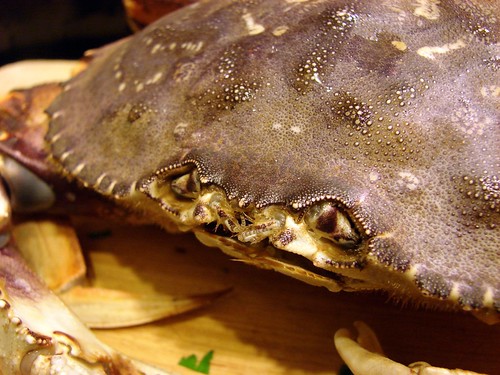
But OH! How I love crab meat! Here’s some lessons learned. Blue crabs are way sweeter than the variety I got when I made my test run a couple of weeks ago. Blue crabs are also smaller, though. So getting the meat out was a SHORE! On the flip, the little blues I got this week, actually had roe in them. I guess next time it will be a call between the ease of the larger crab vs the sweetness and possible roe to be found in the blue ones. Who knows.
What I do know, is that this bisquey-chowdery-creamy soup goodness is out of this world delicious! Aside from making the stock from the live crabs, it was also a breeze. Not that the broth making was difficult, it was the crab meat pulling that proved tedious.
I did learn a little trick for dealing with the live critters. See, I’m not perturbed by their ugly little mugs. I don’t have a problem eating food that looks back at me. I can look ‘em in their beady little eyes and still eat them. But if there had been a candid camera in the kitchen the day I was trying to get these in a pot, it would’ve made for funny footage. Every time one of the little suckers moved, clawed or reared up, I had a similar and equal reaction. Plus I kept picturing them getting on the floor and scurrying around while I tried to catch them. That’s why this tip is so awesome.
If you put them in the freezer for a few minutes-30 or so, they go into a little slumber that gives you enough time to clean’em up and pot them. All I did was leave them in the bag they came, shove it in the freezer and ignored them for a while.
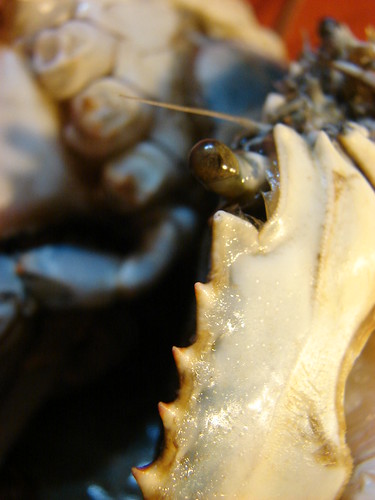
While the crabbies chill out, pun intended, get started on the stock. Any veggies you have laying around will do. I had onions, garlic, celery, carrots, the tops of some leek bunches. No need to get fancy with any of these, a quick rinse and rough chop is good enough. I even left the skins on the onions, garlic and carrots.
Just put the whole thing in a stockpan, add enough water to cover the crabs once you put them in (about 12 cups or so). Add a couple of bay leaves and if you have whole peppercorns, throw about 1 tbsp of those in. I put them on the cutting board and squashed them with the handle of a heavy knife, just enough to break them a bit. Add 2 tbsp of sea salt, cover the pan and bring it all to a boil for about 5-10 minutes. While this is happening, get back to your crabs.
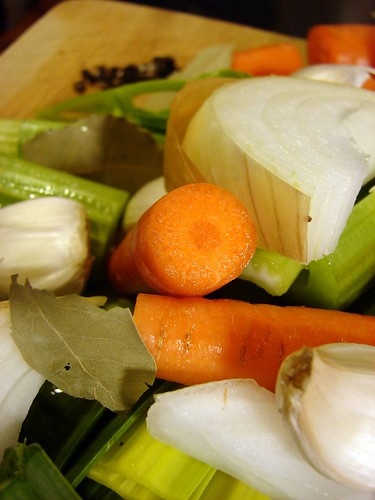
Once you’ve gotten the crabs good and drowsy, it’s easy to remove the big front claws. You want those off before they wake up again or you may end up missing a finger. With the claws removed, you can now give them a little scrub to get any debris off. Don’t forget these are bottom-feeders.
After cleaning them, remove the little plate that protects their underbody. Don’t dispose of it, though, any and all shell matter will enhance the stock you’re about to make.
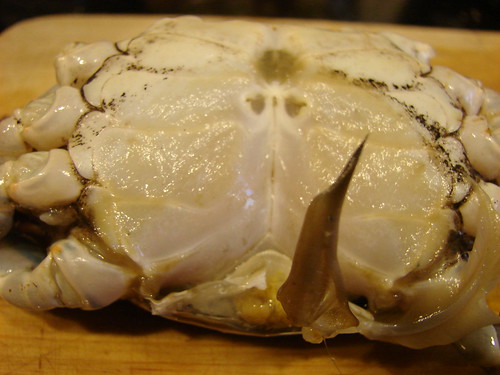
Next, take a knife and break straight through the crab. Essentially, cut the sucker in half. When you remove any pieces from the crab, there will be a bit of liquid that comes out, make sure you’re breaking the crab over a bowl and do the best you can to hold on to that liquid. I can’t be sure, but I would think it is similar to the juice you find when you open an oyster.

In any case, place the crab pieces into a bowl until you’re ready to throw them into the stock. Break apart the little legs too, there’s hardly any meat in them and you can leave those in the stock while you shell the meaty parts.
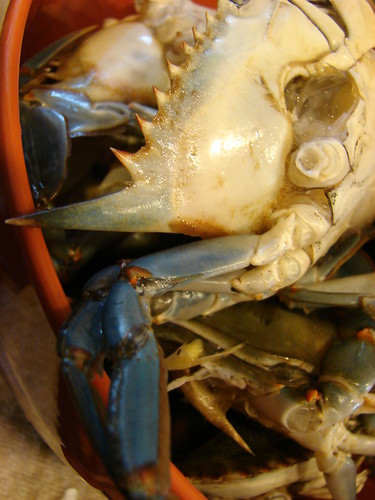
With the crab cleaned, you’re ready to cook them. While the stock is still boiling, drop all the crab pieces in and allow them to cook for about 10-12 minutes. After that time, you’ll want to remove the pieces that hold meat and shell them.
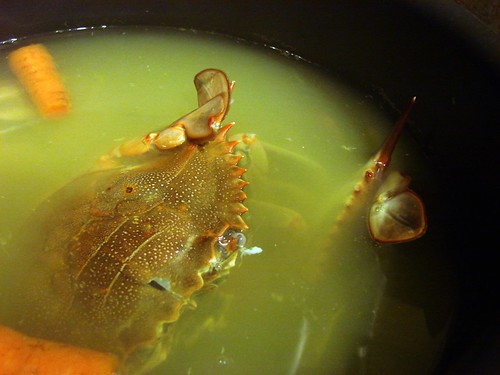
The shells will turn a pretty shade of orange. Lower the temperature on the stock, you now want it to simmer. As I mentioned, any portions that do not hold meat can stay in the pot. Allow the meaty pieces to cool before you begin handling them. As you remove the meat from the shells, throw the empty shells back into the stockpot.
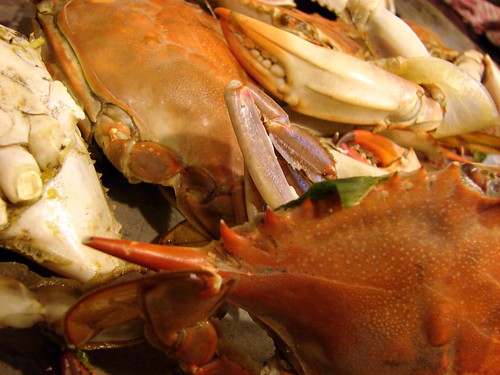
Allow the shells to cook in the stock for about an hour or so. Then turn off the heat and let it cool. Remove all the large bits out of the stock and strain it through a fine sieve. Set the stock aside. Next, we’re starting the soup.
As luck would have it, I didn’t have an actual working recipe, I found a ‘how to make it’ blurb that sounded as authentic as this soup can get and I went with that. I will share a ‘this & that’ recipe with you since I made it twice. I can tell you that it’s not one of those dishes you can mess up. Once you have the stock, it’s easy-breezy.
Back in the day, this soup was made with female crabs and their roe was harvested and added to the broth. You may have a difficult time finding crabs with roe, as crabbers are required to toss them back in the water. The little blue crabs I purchased for the second soup, had tiny bits of roe inside. Yep, I kept it and added it to the soup; I didn’t have any the first time and I couldn’t tell a difference in the taste. What I’m trying to say is, roe isn’t a deal breaker.
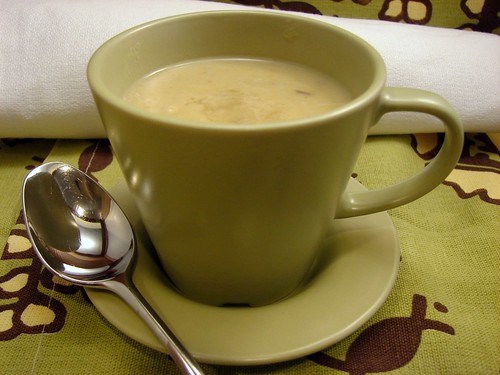
She Crab Soup
To make about 12 cups of soup:
2 tbsp extra virgin oil
1 large onion, chopped
3-4 garlic cloves, chopped
2 celery stalks, chopped
2 bay leaves
2 cps whole milk
1 cp sherry, plus more to serve
10 cps crab stock
1 cp long grain rice
1 tsp Worcestershire sauce
Sea salt & black pepper
1/4-1/2 tsp mace
1/2 cp heavy cream
About 3 cps crab meat (whatever you pulled from the live crabs, plus 1 store-bought container–approx 8 oz)
In a medium sized pan, heat the oil before adding the onions, garlic and celery, cook them until they are clear. Add 1 cp of sherry to deglaze any drippings that may be stuck to the bottom of the pan. If you found any crab roe, add it now together with the bay leaf, rice and stock. After it begins to boil, add the milk and lower temperature to a slow simmer. It will need to cook for about 30 minutes for the rice to soften. Make sure you stir it every once in a while.
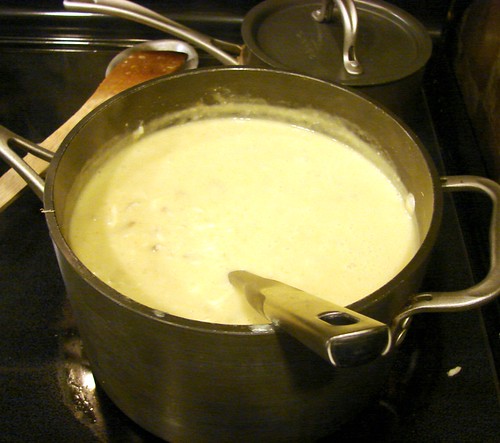
Once the rice has cooked and exploded, remove the bay leaves and ladle this broth into the glass of your blender and puree it. This part can be made ahead of time and refrigerated until you’re ready to serve it. The rice thickens this soup nicely and makes it unnecessary to add lots of cream.
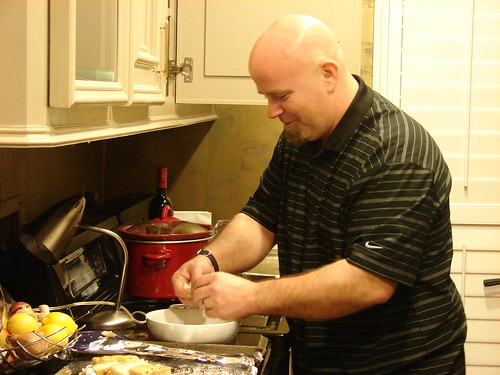
That's hubby making sure there are no shells in the crab meat
Just before serving, heat the blended broth, add the cream, Worcestershire and mace. You can add some hot sauce or cayenne pepper, if you’d like. Finally, add the crab meat and season with salt and pepper, if needed.
To serve, add about 1 tsp of sherry to the bottom of the bowl before ladling the soup. This soup saves quite well in the freezer.

Enjoy!
Cookingly yours,
Anamaris
This was the dessert for the 24, 24, 24 meal. I don’t know how we managed to make it all the way through 8 courses and wine pairings, but we braved it and prevailed.
There was obviously a need for a sweet ending and something creamy, cold and light was what I had in mind. Also, because my focus was regional US foods, I went in search for a dessert that wasn’t the usual New Orleans bread pudding or NY cheesecake, not that there’s ANYTHING wrong with either of those options. Then I read that frozen custard is big in the midwest, Milwaukee, to be precise. Who knew? I have never even attempted to make ice cream or any frozen creamy treats. So I had to do it. I served it with Pinion (pine nuts) Brittle, because pinions are big in New Mexico. Oh yeah.
So, here’s the recipe for Frozen Vanilla Custard with Pinion Brittle. I followed the ingredients from a recipe I found at The Cooking Photographer, but I changed the preparation a bit because I don’t own an ice cream maker thingamajig.

Frozen Vanilla Custard with Pinion Brittle
5 egg yolks
1 vanilla bean
1 cup sugar
2 cups whole milk
2 cups heavy cream
2 teaspoons vanilla extract
Small pinch of salt

In a medium saucepan, add the milk, salt and vanilla bean (make sure you split it in half and scrape the seeds with the back of a knife). Heat the milk until you begin to see bubbles around the edges, make sure you give it a few stirs in between. You want the milk to be very hot, but not boil, turn off the heat and allow the vanilla pod to steep in the milk for about 20 minutes. Set it aside.

Next, place the yolks into your mixer’s bowl and beat at medium speed. Slowly add the sugar until the yolks turn a light yellow. This will take about 2 minutes or so.
Once the yolks and sugar have been incorporated, slowly pour the vanilla mixture into the eggs. Keep the mixer on low to medium speed while you do this, you’re adding the liquid slowly to temper the yolks and avoid curdling. Pour in the rest of the milk after a couple short pours and stir to combine.

Return the mixture to the saucepan and heat over medium stirring frequently until it begins to thicken to about the consistency of condensed milk. Make sure not to allow it to a boil and that you’re watching over it like a hawk. This will take about 15 minutes or so, but it’s time well spent if you want to end up with perfect custard.

Remove from heat, stir in the vanilla extract and empty into a storage container, be sure to leave the vanilla bean in it. Cover with plastic wrap, placed directly over the custard, then seal with an air-tight lid and put it in the refrigerator for at least 3 hours or overnight to chill and set up the custard.

Next, beat the whipping cream using your mixer. You want the cream to be firm, like stiff clouds. Remove the vanilla bean from the custard and fold it into the beaten cream. Make sure you work it in so you don’t end up with lumps of plain cream. Return the whole thing to the storage container, again, cover it with plastic wrap directly on top of the custard, then seal with the lid.

Place the whole thing in the freezer, about 2 hours later take it out of the freezer and stir it around, bringing the frozen edges towards the center. Repeat this step once more before serving. It will need about 6 hours to set completely.
Pinon Brittle
3/4 cup shelled piñon or pine nuts
1 1/2 cups sugar
1/2 teaspoon ground allspice
1/2 teaspoon salt
Line a baking sheet with parchment paper or silpat and butter paper well. In a small frying pan over low heat, toast nuts until they turn light golden brown, 7 to 10 minutes. Set aside.

In the same over medium heat, combine sugar, allspice and salt. Cook, stirring constantly, until mixture is smooth and dark brown. If mixture is darkening too quickly, remove from heat, stir well, then return to heat. When sugar is entirely melted, stir in nuts. Quickly pour mixture onto parchment paper and spread 1/8 to 1/4 in. thick. Let cool until hard, then break into pieces.

Brittle yumminess!


Unfortunately I don’t have a backyard, so I couldn’t dig a great big pit to roast this pork in, but there was no need. This baby was crock-potted overnight after rubbing some salt, liquid smoke and garlic on it. The result? HA! I can’t believe you had to ask.
This was such a hit! It is incredibly simple in its ingredients and preparation, but the flavor…OH the flavor! I think the name is funny, but it’s probably because in Hawaii they WOULD roast the entire pig in an inu–an underground pit filled with stones and firewood and banana leaves to protect the food.
Let me tell you a bit about these salts. Salt is salt, right? Well, maybe not. There’s black lava salt, which is salt that has been combined with activated charcoal; I find that this one has a slightly tart and smoky taste. It is also fun to see how it changes the color of the food it is added to. Red Alaea salt is enriched with volcanic red clay and is not as salty as most. I also used some smoked salt which is sea salt that has been smoked over firewood. So, you see, there’s salt and there’s salt.

Kalua Pig
4-5 lb pork shoulder roast
3 tbsp salts (combination of black lava, Alaea, smoked)
3 garlic cloves, crushed
2 tsp liquid smoke (optional)
2 tbsp extra virgin olive oil
Banana leaves, trimmed

There’s not much in the way of prep work here. First I made a ‘rub’ with the salts, garlic, oil and liquid smoke and then rubbed it all over the piggy. Set it aside and let it hang out for an hour or so.

Get your banana leaves ready. The leaves I found were halved lengthwise, so I had to remove the center rib. I also removed all the brown spots, just in case. I laid cooking twine, then the leaves over the twine. Placed the roast on top, wrapped the leaves around it and tied it with the twine. Then I put the whole thing into the crock pot. I added a few more leaves at the bottom, covered it and turned the heat to low. If you can’t find banana leaves, don’t despair, the recipe will be fine without it. Just put the roast straight into th crock pot.

There is no need to add liquid, this will roast very slowly and any fat in the roast will be rendered and that is what the meat will cook in. I left it alone overnight, probably about 8 hours or so. When I checked the center temperature of the roast the next morning, it read at 180°. Perfection! Let it cool in the braising liquid.

You’ll notice the color of the leaves will change dramatically while steaming. If you’ve ever seen or eaten grape leaves, that’s what the color will look like.

The roast I purchased had the outer skin attached, and I L.O.V.E that skin. So to serve it, I heated up a bit of oil in a skillet over medium heat, then placed the roast, skin side down onto the skillet. I covered it with aluminum foil as it can get quite spattery and allowed it to crisp for about 10 minutes before flipping it to the other side. However, Hawaiians serve this by pulling the meat with forks.
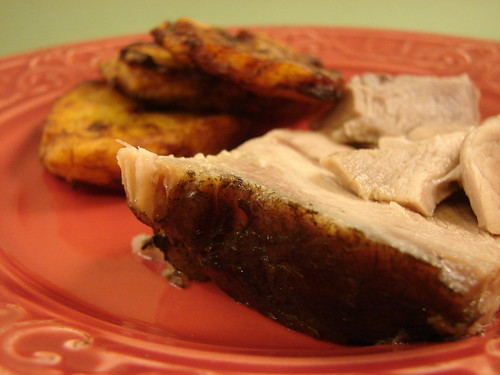
Another thing I loved about this dish, was how unusual it looks. The lava salt gives the meat a charcoaly-grayish tone. It seems odd to eat black food.
Cookingly yours,
Anamaris
As a Foodbuzz featured publisher, I was given the opportunity to prepare and document a meal. The concept was to have friends over to enjoy dishes from the various US regions and pair them with US wines.
24 = 8 Foodies + 8 US regions + 8 Pairings
Food and wine pairing has always been fascinating, and daunting to me. I’m not sure how someone develops their senses to the extent necessary to accurately pair a dish with wine that enhances it. That was my goal. Hang out with food and wine loving friends, and experience how wine and food play off each other.
First, divide the US into regions:
- New England: Connecticut, Rhode Island, Massachusetts, Vermont, New Hampshire, Maine, New York, Pennsylvania, New Jersey and Delaware
- Mid-West: Ohio, Michigan, Indiana, Iowa, Illinois, Missouri, the Dakotas, Nebraska, Wisconsin, Minnesota, Kansas and Oklahoma
- West: Nevada, Utah, Colorado, Idaho, Wyoming and Montana
- Deep South: Virginia, West Virginia, Kentucky, Tennessee, Arkansas, the Carolinas, Georgia, Louisiana, Alabama, Mississippi, Florida and Maryland
- Southwest: Arizona, New Mexico and Texas
- Pacific Northwest: Oregon and Washington and Alaska
- California
- The Islands: Puerto Rico and Hawaii
After research, the menu went a little something like this.
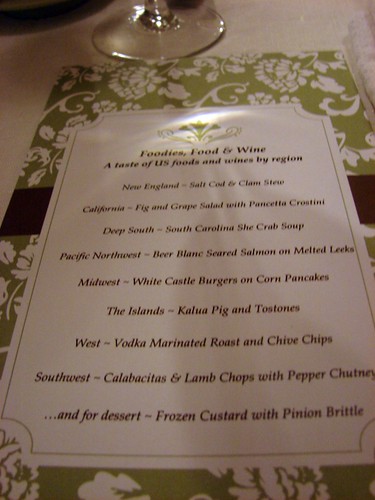
Next, to figure out the wines for these meals. The tricky part, but quite rewarding. The internet is your friend. And mine. I took full advantage of this technological advance. There are 2 sites I found especially helpful. The first one helped get in the right wine range. That is, I typed the general type of food and it gave me suggestions for the best wine pair. Wine Review Online provided choices for specific dishes/recipes as well as by ingredient. The members of the site then offer up reviews of some of their favorites bottles.
Once I knew what type of wine or grape varietal I should be aiming for, I was ready for specific bottles. I wanted all the wine selections to be under the $24 price point, preferably under $20. Good Wine Under $20 was just the right spot for me. I am SO glad I found this site. It is comprehensive and easy to follow and the blog owner provides you with clear reviews about the various wines. Just what I needed.
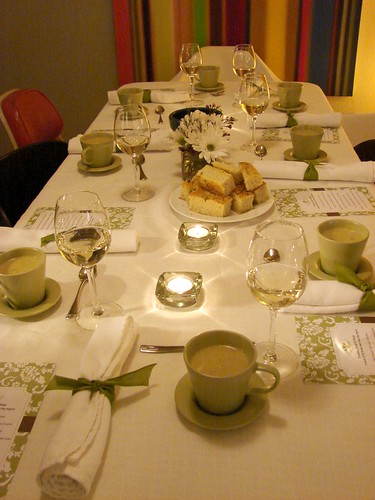
Menu in hand and with my pairing recommendations, this is how the evening played out. Our guests began arriving around 6:30. I printed out the menus and in the back of the card I provided space for each guests’ comments–their thoughts on the dish and how the wine enhanced it, would they ever like to try it again, etc.
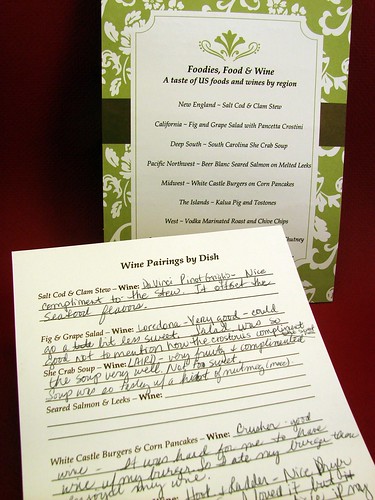
This was a pretty informal bunch, as they arrived we discussed whether to eat the dishes in the ‘proper order’ (salads, seafood, dark meats) or if they just wanted to enjoy the dishes randomly. We agreed on a random approach, none of us seemed terribly concerned with following the white then reds rule. Additionally, most of us have a preference for red wines. In any case, off to the first course we went.

First up, She Crab Soup: a specialty from the South Carolina low country and the signature dish of Charleston. This soup starts off with a crab stock, cooked onions, celery and rice to arrive at the final product. The addition of sherry and mace gave this soup a deep flavor that proved to be highly satisfying with our guests.

Pairing: Grant & Amy chose a bottle of 2008 Laird Sauvignon Blanc. On their comment card they mentioned the soup was great and light with a great nutty taste which paired perfectly with the oaky finish of the wine. Complimenting its smooth body and melon undertones’.
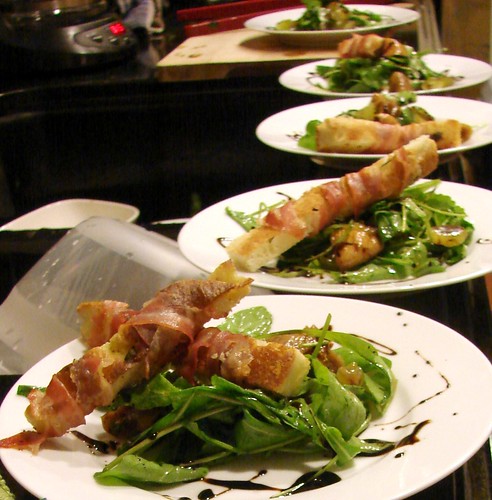
We then moved on to California cuisine with a Fig and Grape Salad with Pancetta Crostini. This was a salad by Alice Waters, one of the chefs who’s had great impact on California’s cuisine. The salad combines arugula, figs, grapes and a balsamic vinegar reduction together with crostinis– bread sticks of focaccia–wrapped in pancetta. The suggestion from my local wine specialist was for a Riesling.
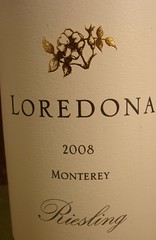
Pairing: I selected a Riesling by Loredona in Monterey County. I found that this wine really balanced the peppery arugula with the sweetness of the figs and balsamic reduction. White wines aren’t my first preference, but this Riesling was not too sweet, while still being refreshing and slightly tart.
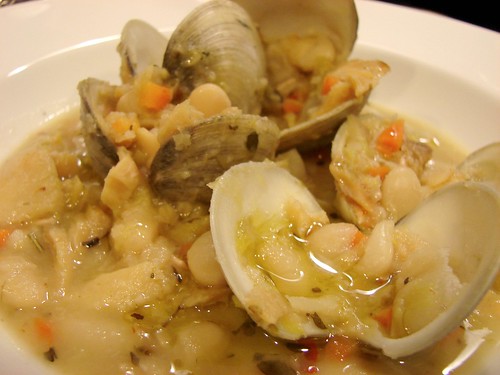
For the New England area, we served a Salt Cod & Clam Stew. The base included cannellini beans, leeks, salt cod and clams. One of the suggestions was to pair it with a Pinot Grigio. Jay and Angie brought us a bottle of DaVinci Pinot Grigio. Apple and citrus flavors helped to tone down the saltiness inherent to the cod.
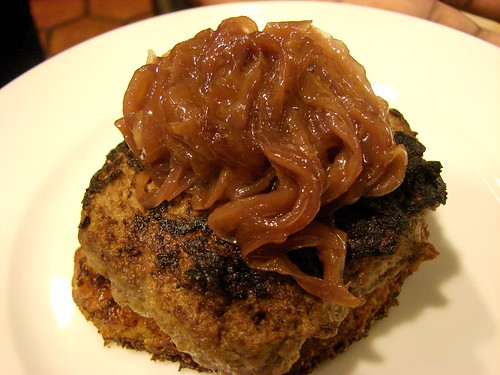
For the Midwest we took a stab at White Castle burgers and saluted the corn growers in the area. This course was an open-face White Castle inspired burger–served on a corn fritter and topped with caramelized onions. The wine recommended was a Petite Shiraz.
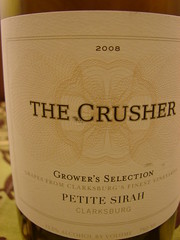
Pairing: GWU20 suggested a bottle of 2008 The Crusher Petite Shiraz and OMG! This is a beautiful wine! We were first struck by the color; the deepest purple I’ve ever seen in a wine. This is immediately followed by the herby and fruity aromas emanating from the glass. Someone commented on how the wine complimented the sweetness of the onions and peppery notes in the burger. This is a bottle that will always be on our shelf.
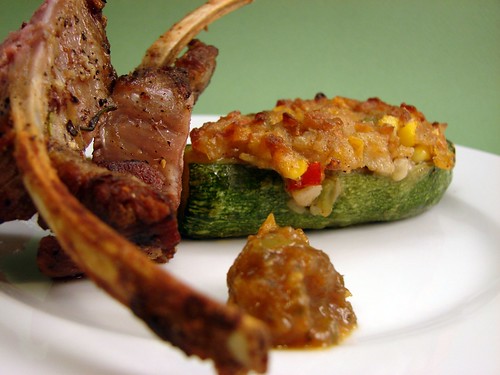
For the Southwest we had Lamb Chops with Pepper Chutney and Calabacitas. Mildly gamey, tender meat that comes alive with a sweet and spicy chutney that brought your mouth to life. The wine suggested was Cabernet Sauvignon.
Pairing: We selected a bottle of Barefoot Cabernet Sauvignon. This is definitely a budget bottle, but it tamed the heat of the chutney while bring out the sweetness and peppery notes of the dish. For a bottle under $10, it was a nice compliment.

The islands: Hawaii & Puerto Rico. Kalua Pig and Plantains-I made a last minute change and included both, green and ripe plantains. This was the sleeper dish. Nothing about it was supposed to be exceptional, and yet, it was. The pork is rudimentary seasoned with Hawaiian salts and slow cooked wrapped in banana leaves. There’s no smoke and mirrors here, it was straight forward meat preparation. Meat+salt+garlic+wrapping (leaves)+ slow cooking.
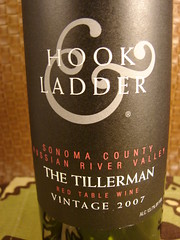
Pairing: Hook & Ladder The Tillerman. This is a nice Cabernet blend with a rich medium body. Not too boisterous to overpower the simplicity of the pork, but not shy enough to be ignored.

The Pacific Northwest was well represented by salmon. A pan seared Salmon Beer Blanc over Melted Leeks turned out to be a beautifuly simple dish. The salmon drippings were deglazed with a bit of shallots and red ale. And the leeks were cooked down in olive oil leaving a creamy oniony puree. The wine recommendation was a Pinot Noir.
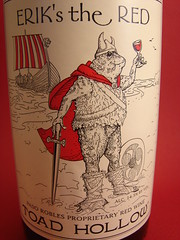
Pairing: Toad Hollow Erik’s The Red. An awesome blend of about 18 varietals makes it an awesome house red. It was smooth and herby, which contrasted wonderfully with the leeks and oiliness of the salmon.
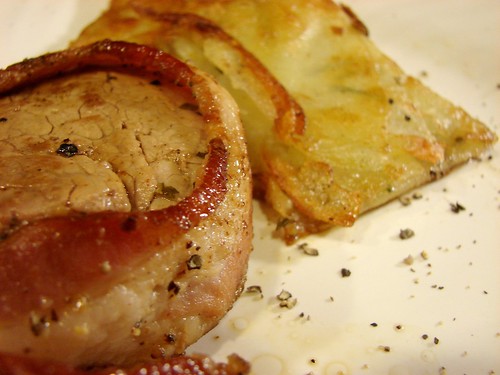
The Western United States brought us up close and personal with meat and potatoes. The last minute substitution of filets instead of roast and potato gallette instead of chips was quite well received. The wine recommendation was Zinfandel.
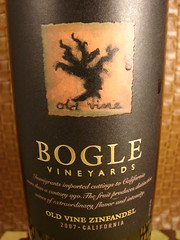
Pairing: The beef was marinated in vodka, salt and garlic, then seared wrapped in bacon. A side of potatoes and chives rounded up the plate. An Old Vine Zinfandel by Bogle proved to be the right wine, providing a nice spicy finish to the almost creamy, delicate texture of the filets.
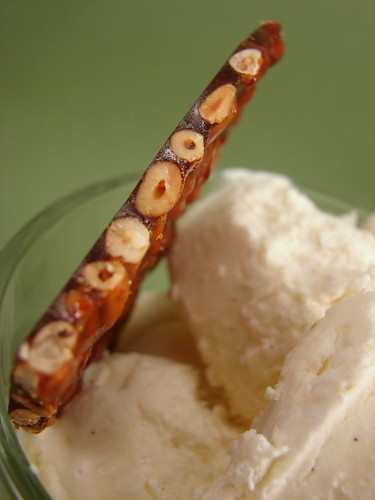
Then there was dessert. Vanilla Bean Frozen Custard with Pinion Brittle. Creamy, cold, coupled with a nutty and slightly bitter brittle. This was served with Trentadue Chocolate Amore. It’s a merlot based, chocolate flavored dessert wine. I heard no complaints.
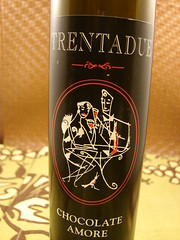
Lessons Learned
- An evening with 8 meal courses is VERY ambitious. I don’t think they’ve invented stretchy enough pants yet. However, when you hang out with friends who love eating and drinking as much as you do, anything is possible.
- Wine and food are like an old married couple: they don’t always like each other, but they just make each other better. All that’s required is a willigness to discover each other’s secrets.
- Food & Wine Pairing doesn’t have to be rocket science. Google is your ally and so is the quirky person that answers your wine questions at the store. If you don’t know, just ask.
- It’s always about what works for you. Don’t bog yourself down with rules. Taste foods and then have some wine, you may find that it brings out something unexpected.
- Wisdom comes from experience. Play with your food and wine, experience and experiment, then document for future generations.
Thanks again to Foodbuzz for the opportunity to throw down with wine and food and to share this with friends and all of you. The various recipes will be posted throughout this week, you really don’t want to miss them. There were a lot of very surprising treats.
Cookingly yours,
Anamaris

This is an incredibly easy dish to prepare, delicious to boot! I want you to be comfortable with it, though. There are 3 key players, spaghetti–or any noodle pasta you like–pancetta (Italian bacon) and eggs, make sure your eggs are fresh. That’s it, really.
I made a few changes to a basic recipe by Ruth Reichl and only because I’m honery that way. Also because I love bacon with onions. And onions with pasta. And eggs with onions. And pasta with eggs. You get my drift. I didn’t have pancetta, so I used bacon, not that there’s anything wrong with either one. Also, when I was at the store they had that beautiful black peppered bacon, so I went halfzies.
Here’s what I’ll tell you ahead of time:
- Cube the bacon/pancetta
- Leave your eggs out so they’re room temperature
- Use a big mixing bowl to put it all together and fill it with warm water until it’s time to toss the pasta in
Spaghetti Carbonara
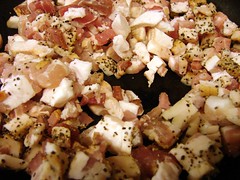 1 pound spaghetti
1 pound spaghetti
8 strips thick bacon, finely cubed
8 strips thick black pepper bacon, finely cubed
2 cloves garlic, peeled and bruised
1 small onion, finely diced
2 large eggs
Fresh ground black pepper
1/2 cup grated Parmigiano cheese, approx
1/4 cp Italian parsley, finely chopped
Put the bacon into a skillet over medium heat and cook for a few minutes to render its fat. While it’s cooking add the onions and garlic, cook about 5 minutes until the onions are translucent and melting away. While the bacon and onions are cooking, fill a large pot of water to cook the pasta. Bring it to a boil and add salt once it does. Add the pasta and give it a stir to keep it from sticking.
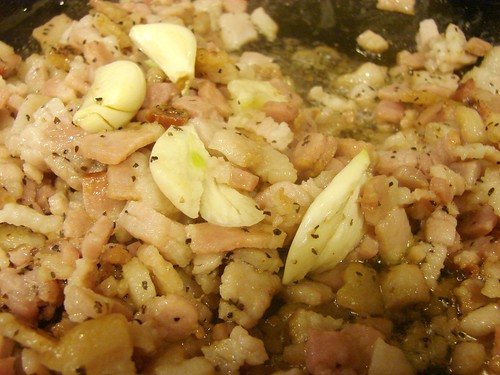
Note: the bacon will not be crisp, which is ideal when you toss it with the pasta and eggs.
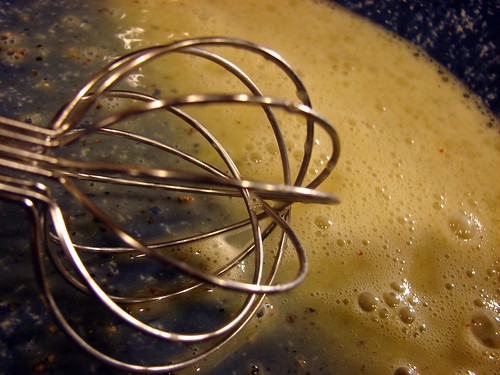
Dump the water out of the serving bowl, break and whisk the eggs. Grind some black pepper and whisk. By now the bacon and onions should be ready, keep it warm until the pasta is cooked. Don’t discard all the pasta water when you drain the noodles. As a matter of fact, I pulled the spaghetti straight out of the pot and into the eggy bowl. That way, I pulled in a bit of the pasta water to aid in making the sauce.
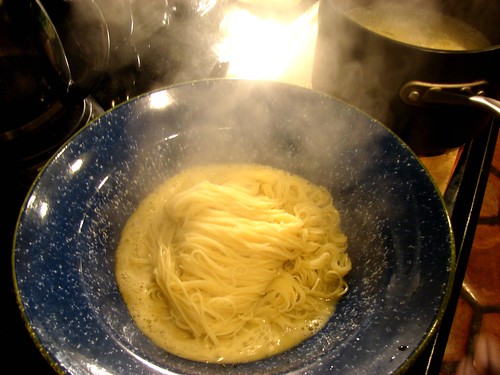
The pasta is so hot that it will cook the eggs almost on contact, so make sure to toss and incorporate the two every time you add pasta. Once all the spaghetti is in, add the bacon onion mixture (fat and all), parsley and about 1/4 cp of Parmesan. Add more pasta water as needed, just enough to make the dish moist.
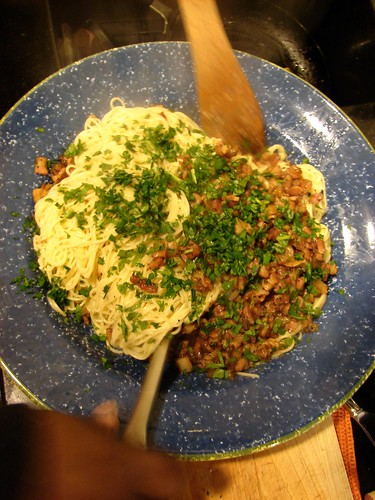
That’s it. Serve immediately with additional cheese to taste.
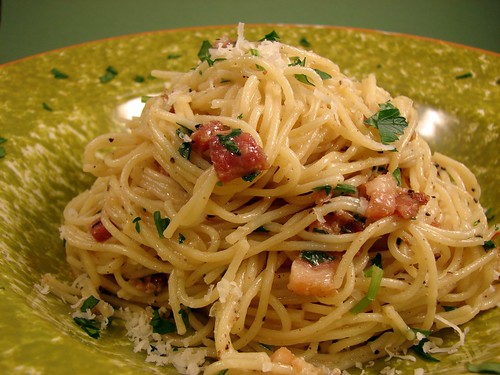
Cookingly yours,
Anamaris
Throwing a Dinner or Cocktail Party
I have a big dinner coming up this weekend. I am 1 of 24 featured publishers selected by Foodbuzz to give readers an inside look at a dinner. My concept is to highlight foods by region–US regions and couple those with US wines. Sounded like a swell idea, I’ve always been interested in determining how to pair foods and wine. There’s been a great deal of research involved, now that it’s done, I will share with you how I go about organizing similar events.
Here are the prep steps, as I see them:
- Select theme
- Set the menu
- Guest list & Invitations
- Date & Time
- Venue & Decor
- Shopping lists
- Prep work
- D-Day set up
- Putting it all together
- Enjoy your labour of love
First things first – Themes and Menus
The first 3 steps are interchangeable, but they should be the first things you take into consideration when planning your soiree. Depending on the type of event, say something informal like a cocktail or Superbowl party, you can decide on menu items at any time because, most likely, you’ll have nibbles that will conform to most guests needs. If, on the other hand, you’re planning a more intimate dinner, then you need to make sure all guests will be comfortable with the planned menu.
The last is the scenario I’m faced with this time. I have a clear concept in mind, sorta, so my guest list was limited to friends who enjoyed food–old and new, basic and exotic–as well as wine. I had to be deliberate about those I invited, particularly since it was limited to 6 guests. When you know who will attend and you know their eating preferences, you’ll have an easy enough time determining the menu.
Guest List & Invitations
Who do you want to spend time with? What is the reason for your dinner party? Are you celebrating something or someone? These are some the questions to consider when you’re in the planning stages. Also keep in mind the size of your venue, make sure your guests will be comfortable.
Invitations: this is entirely up to you and, to some extent, how formal the event is. I wouldn’t send evites for a wedding reception or a 25th wedding anniversary. But evites are my favorite modus operandi. They’re easy, it allows me to know without a doubt who has received it, makes your guests’ lives simpler by simply hitting a quick reply button and there are so many designs available and it is environmentally friendly.

If you will be mailing paper invitations, choose a design that mimics your decor concept. Make sure you have the full names and correct addresses of your guests. Include an RSVP by date and mode (call you, send a card back, smoke signals). If you’re including an RSVP card, make sure you provide them with the stamp and have the cards addressed to you.
Time & Date
The date for this event was predetermined for me: February 27th. Since this will be an elaborate 8-course meal (yeah, I have NO clue what I was thinking about), I set the start time to 6:30pm. I’m assuming each course will take about 30 minutes from presentation to discussion. Keep your fingers crossed for me, will ya?
When you’re determining the time for your event, you will consider what meal will be served, how much preparation needs to happen while the guests are already there and then give them enough time to not only eat, but enjoy the course served, compliment the hostess, beg for the recipe, blah, blah.
Venue & Decor
Where will this shindig take place? At your home or a friend’s? A restaurant? Park? Again, the theme and guests will determine the where. For me, I was thorn. I knew it had to be near a kitchen and that I wanted it to be homey and cozy. I had thoughts about having it at a friend’s home, she has more room than I do. The reality is that I will be preparing quite a bit of the courses on the spot and most of the side dishes will be made the day of. Transporting pots, dishes, pans through Houston seemed Nightmare on Elm Streetesque. So, home it is. Our home. Where I know all my nooks and crannies. Where I know where all the pots and spoons are. How hot the oven cooks. You know, home.
As for decor, flowers are always a must. Flowers and candles make any room look and feel especially special and that’s how I want my guests to feel. I have a couple of standard vases I love and I pick up a few blooms from my local grocer. I’m not a terribly inspired floral arranger, but floors look good without the wanting for much. One arrangement on the coffee table–a medium sized one. A couple of loose blooms in the bathrooms. Some tealights strewn about the room and votives on the table. Keep your flowers in the same color palette and you’ll have settings to die for.
Shopping Lists
I like ‘em. I don’t always pay attention to them, but when it’s time for a dinner party, I’m militant about it. That’s because of my super short attention span. If I don’t pull out my list as soon as I walk into the market and proceed to check things off as I find them, I will, inevitably, leave a few things behind.
So, once I have tweaked the menu, I write down the ingredients for the various recipes. I check my pantry for items I may already have and then i make my way through the aisles of stuff.
I also make a list of any serving dishes, silver, dinner, barware that may be needed for the event. That way I make sure I find what’s missing, whether I borrow, steal or buy it. Well, not steal. I just wanted to see if you were still paying attention. Designate what entrée will be served in which dish/plate, and make a note of it. If you figure this out ahead of time D-Day will be a breeze.
Prep Work
The best part about a dinner party is getting to enjoy the company of friends and loved ones. That is why I do my very best to do as much of the heavy lifting ahead of time. Make sure you have sides that will reheat well, even entrees. Desserts too.

This is also a good time to get all your dishes cleaned and ready. Load up the dishwasher for a quick rinse and set everything to the side. If you’re using fresh flowers, get them ready the day before. That will give the arrangements time to chill out and get comfy and gorgeous.
D-Day – The Set Up
If your event is at home, do any last minute cleaning and freshing up your home may need. Make sure the ambient temperature is cooler than normal–you will be running the oven or stove and you’ll have more people in your home than you usually do.
Start cooling your wine or beer bottles at least 3 hours earlier. Decide if you’d like to play some music and have the playlist ready to go. Set the table, put out the flowers and candles. Get the ambience going.
Also, take a moment to determine the sequence in which you need to reheat, toss or prepare any of the dishes you’re serving. Hopefully you’ve prepared some items ahead of time, make yourself a note of what needs to hit the oven or boiling water when.
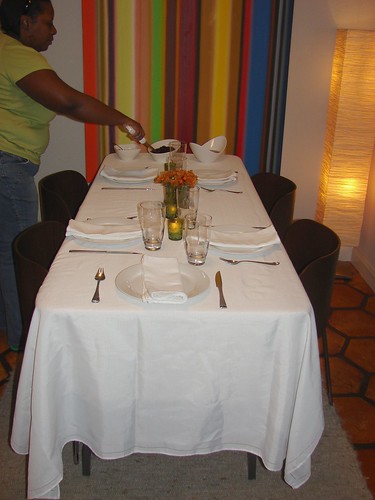
Putting it all together
Say you’re serving a green salad, angel hair pasta with meat sauce, bread sticks and warm apple pie. You would make the meat sauce the day before (it will taste WAY better too) and chill it. Make your crust the day before as well. Then the day of, you begin to heat your meat sauce about 20 minutes before guests get there. At the same time you fill a pot with water and put it on the stove over medium low heat to get the water warmed up. The oven goes on after your first guest arrives to bake/reheat the bread sticks. After everyone has said hello, toss your salad greens, throw the bread in the oven and bring up the temperature of the water. Enjoy half your salad, go in the kitchen and throw in the pasta and come back to the table finish that yummy salad.
See? It’s all about being ready and timing the sequence of events. While everyone is eating, you can bake that pie.
Enjoy your labour of love
Pour yourself a tall one, mingle and giggle and enjoy your friends. Stop by on Sunday when my official 24, 24, 24 post will be up.
Cookingly (and entertaingly) yours,
Anamaris


 1 oz orange liqueur (like Triple Sec, Grand Marnier, etc.)
1 oz orange liqueur (like Triple Sec, Grand Marnier, etc.)




























































 1 pound spaghetti
1 pound spaghetti






